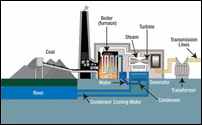Depopulating Sampoor
by TamilNet, December 28, 2006
|
Sri Lankan military officials and the hardline bureaucracy in the East port town, have been quick to seize the opportunity following the military capture of Sampoor and the eviction of Tamils from the Muthur East region, and are now advocating to shift the site of the coal power plant.[from an area which would affect Sinhalese settlers the most to one which would affect Tamil residents.] ...
The advocates of the power plant in the Sampoor region seem to think that a military victory alone would not be sufficient, in the long run, to evict Tamils from the region, permanently. |
Indian state-owned National Thermal Power Corporation (NTPC) is set to sign a Memorandum of Understanding (MoU) with Colombo, on Friday, amid protests from Tamil parliamentarians who are voicing concerns that the Coal-Fired Power Plant project in Sampoor has a hidden political agenda - to permanently evict Tamils from the Muthur east region.
Around 30,000 Tamils were forced to leave the southern Trincomalee region, fleeing into Vaharai, when the Sri Lanka military launched a major offensive and captured Sampoor from the Liberation Tigers of Tamil Eelam in September.
Indian High Commissioner Alok Prasad will be present at the Sri Lankan Presidential Secretariat when the agreement between Sri Lanka and India to build a 500MW imported-coal power plant is signed Friday, media sources in Colombo said.
Tamil National Alliance (TNA) parliamentarian from Trincomalee, K. Thurairetnasingham, in a media release, slammed the Government of Sri Lanka for rushing with the project without consulting the Tamil representatives, while thousands of Tamils have been forced to flee the region. The power plant will have a permanent adverse impact on the future livelihood of Tamils in the region, Thurairetnasingham said.

Sections of the Sri Lankan establishment are advocating to shift the proposed coal power plant from the location identified earlier in 2002 near Veppankuda, above the Marble Beach, to Sampoor region on the opposite side of Koddiyar Bay. |
Colombo has been engaged since April this year with the politico-military objective to capture the Tamil-populated territories in southern Trincomalee and Northern Batticaloa, and has already engineered the exodus of more than 30,000 Tamils from the region, the MP charged. Tamils have fled from nearly 30 villages, including Sampoor, Kadarkaraichenai, Chenaiyoor, Ilakkanthai, Sudaikudah, Pattalipuram and Koonithivu in Muthur east during the SLA's recent offensives.
The first coal power plant is already being set up with Chinese assistance, amid strong protests from the civilians of the area, in Norochcholai in the Puttalam district in the west of the island.
In the East, the Indian Oil Corporation, took over 99 storage tanks of World War II vintage in the Trincomalee Oil Tank Farm in 2003 during the peace process.
Sri Lanka viewed the Indian presence in Trincomalee as a part of its "international safety net" against the Tigers.

Feasibility tour by Indian experts and Sri Lankan officials with UNP (now SLFP) minister Rohita Bogollagama, 17 May 2002 [Library Photo] |
On the 17th and 18th May 2002, Rohitha Bogollagama, then Minister of Industries under United National Front (UNF) Government, together with the Indian National Thermal Power Corporation officials, carried out a feasibility study for the coal plant, and selected a location near the China Bay airstrip inside the High Security Zone in the Trincomalee Harbour to build the coal-fired power plant. Mr. Bogollagama is currently Minister of Enterprise Development and Investment Promotion, having crossed over to the SLFP from the UNP two years ago.
During the 2002 evaluation, concerns were raised that the tall chimney of the Coal Power Plant may disrupt the landing of aircraft at the China Bay airbase. Foreign experts assured local officials that the chimney will not be a hinderance to the air traffic.
However, Colombo abandoned the location later, believed to be due to pressure from the Sinhala lobby which was concerned over the polution of the Sinhalese-populated Kantalai area lying to the southwest of China Bay along the direction of monsoon winds.
In October this year, when the Sri Lanka Ministry of Power and Energy, announced their plan to construct a coal power plant using a loan from the Indian Government on concessionary terms, the Indian Government officials denied their participation in the project.

In Coal-fired power plants, coal is burnt in a furnace to heat re-circulating water that produces steam at high-pressure. The steam is fed through a steam-turbine to produce torque driving an alternator to produce electricity. Low pressure steam from turbine outlet is cooled by external water in a condenser and refed into furnace. |
Power plants typically require a long jetty in their proximity. By moving the project from China Bay to the opposite side of Koddiyar Bay at Sampoor, despite the absence of a deep-sea jetty for unloading, large tracts of arable land will likely end up as a storage area for coal. Or a new jetty must be built at high cost.
The Tamil areas that have survived Sinhala colonisation will be affected with micro-particle dust from burning coal, civil society sources in the east say. In addition, the haze will reduce visibility in the region and obscure the spectacular vistas along pristine local beaches.
Power plants on average have a useful life of fifty to sixty years, and emit large amounts of carbon dioxide (1 million tons of CO2 per 100MW) and other greenhouse gases into the atmosphere. Sulfur dioxide and oxides of nitrogen, which cause environmentally hazardous acid-rain, are also emitted. Poisionous mercury is released to the air.
Further, warm water outflow from the cooling pipes to the power-plant condenser will be discharged into the sea, and this will deplete the fish stock along the coast. The livelihood of Tamil fisher families along the coastal villages will be endangered.
Sri Lankan military officials and the hardline bureaucracy in the East port town, have been quick to seize the opportunity following the military capture of Sampoor and the eviction of Tamils from the Muthur East region, and are now advocating to shift the site of coal power plant.[from an area which would affect Sinhalese settlers the most to one which would affect Tamil residents.]
Developmental zones in Trincomalee town have been systematically colonized and the Tamil areas have been neglected in [other, less environmentally racist] development with a long term politico-military objective in Trincomalee.[of changing the ethnic balance in the strategic harbor city]
The advocates of the power plant in the Sampoor region seem to think that a military victory alone would not be sufficient, in the long run, to evict Tamils from the region, permanently.
Follow-ups:
29.12.06 India, Sri Lanka sign agreement on Trinco coal pla..
External Links:
|
 Home
Home Archives
Archives Home
Home Archives
Archives